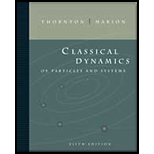
(a)
The natural frequency
(a)
Answer to Problem 3.1P
The natural frequency
Explanation of Solution
Write the formula to find the natural frequency
Here,
Write the formula to find the period
Here,
Conclusion:
Substitute
Thus, the natural frequency is
Substitute
Thus, the period is
(b)
The total energy.
(b)
Answer to Problem 3.1P
The total energy is
Explanation of Solution
Write the formula to find the energy
Here,
Conclusion:
Substitute
Thus, the total energy is
(c)
The maximum speed.
(c)
Answer to Problem 3.1P
The maximum speed is
Explanation of Solution
The maximum velocity of the system is attained when the total energy of the system is equal to the kinetic energy of the system.
Write the formula to find the kinetic energy
Here,
Conclusion:
Substitute
Thus, the maximum velocity is
Want to see more full solutions like this?
Chapter 3 Solutions
Classical Dynamics of Particles and Systems
- Show that, if a driven oscillator is only lightly damped and driven near resonance, the Q of the system is approximately Q2(TotalenergyEnergylossduringoneperiod)arrow_forwardPlot a velocity resonance curve for a driven, damped oscillator with Q = 6, and show that the full width of the curve between the points corresponding to is approximately equal to ω0/6.arrow_forwardA simple harmonic oscillator has amplitude A and period T. Find the minimum time required for its position to change from x = A to x = A/2 in terms of the period T.arrow_forward
- Give an example of a simple harmonic oscillator, specifically noting how its frequency is independent of amplitude.arrow_forwardCheck Your Understanding Why are completely undamped harmonic oscillators so rare?arrow_forwardAn automobile with a mass of 1000 kg, including passengers, settles 1.0 cm closer to the road for every additional 100 kg of passengers. It is driven with a constant horizontal component of speed 20 km/h over a washboard road with sinusoidal bumps. The amplitude and wavelength of the sine curve are 5.0 cm and 20 cm, respectively. The distance between the front and back wheels is 2.4 m. Find the amplitude of oscillation of the automobile, assuming it moves vertically as an undamped driven harmonic oscillator. Neglect the mass of the wheels and springs and assume that the wheels are always in contact with the road.arrow_forward
- If the amplitude of a damped oscillator decreases to 1/e of its initial value after n periods, show that the frequency of the oscillator must be approximately [1 − (8π2n2)−1] times the frequency of the corresponding undamped oscillator.arrow_forwardA pendulum with a period of 2.00000 s in one location (g=9.80m/s2) is moved to a new location where the period is now 1.99796 s. What is the acceleration due to gravity at its new location?arrow_forwardC, N A uniform plank of length L and mass M is balanced on a fixed, semicircular bowl of radius R (Fig. P16.19). If the plank is tilted slightly from its equilibrium position and released, will it execute simple harmonic motion? If so, obtain the period of its oscillation.arrow_forward
- We do not need the analogy in Equation 16.30 to write expressions for the translational displacement of a pendulum bob along the circular arc s(t), translational speed v(t), and translational acceleration a(t). Show that they are given by s(t) = smax cos (smpt + ) v(t) = vmax sin (smpt + ) a(t) = amax cos(smpt + ) respectively, where smax = max with being the length of the pendulum, vmax = smax smp, and amax = smax smp2.arrow_forwardRefer to the problem of the two coupled oscillators discussed in Section 12.2. Show that the total energy of the system is constant. (Calculate the kinetic energy of each of the particles and the potential energy stored in each of the three springs, and sum the results.) Notice that the kinetic and potential energy terms that have 12 as a coefficient depend on C1 and 2 but not on C2 or 2. Why is such a result to be expected?arrow_forwardShow that the time rate of change of mechanical energy for a damped, undriven oscillator is given by dE/dt = bv2 and hence is always negative. To do so, differentiate the expression for the mechanical energy of an oscillator, E=12mv2+12kx2, and use Equation 12.28.arrow_forward
 Classical Dynamics of Particles and SystemsPhysicsISBN:9780534408961Author:Stephen T. Thornton, Jerry B. MarionPublisher:Cengage Learning
Classical Dynamics of Particles and SystemsPhysicsISBN:9780534408961Author:Stephen T. Thornton, Jerry B. MarionPublisher:Cengage Learning Physics for Scientists and Engineers: Foundations...PhysicsISBN:9781133939146Author:Katz, Debora M.Publisher:Cengage Learning
Physics for Scientists and Engineers: Foundations...PhysicsISBN:9781133939146Author:Katz, Debora M.Publisher:Cengage Learning University Physics Volume 1PhysicsISBN:9781938168277Author:William Moebs, Samuel J. Ling, Jeff SannyPublisher:OpenStax - Rice University
University Physics Volume 1PhysicsISBN:9781938168277Author:William Moebs, Samuel J. Ling, Jeff SannyPublisher:OpenStax - Rice University Principles of Physics: A Calculus-Based TextPhysicsISBN:9781133104261Author:Raymond A. Serway, John W. JewettPublisher:Cengage Learning
Principles of Physics: A Calculus-Based TextPhysicsISBN:9781133104261Author:Raymond A. Serway, John W. JewettPublisher:Cengage Learning Physics for Scientists and Engineers with Modern ...PhysicsISBN:9781337553292Author:Raymond A. Serway, John W. JewettPublisher:Cengage Learning
Physics for Scientists and Engineers with Modern ...PhysicsISBN:9781337553292Author:Raymond A. Serway, John W. JewettPublisher:Cengage Learning Physics for Scientists and EngineersPhysicsISBN:9781337553278Author:Raymond A. Serway, John W. JewettPublisher:Cengage Learning
Physics for Scientists and EngineersPhysicsISBN:9781337553278Author:Raymond A. Serway, John W. JewettPublisher:Cengage Learning





